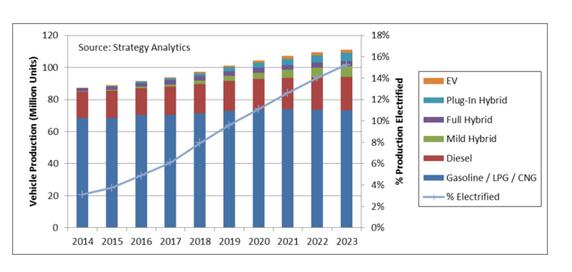Although electric cars and hybrid cars have made great strides along the way, traditional gasoline and diesel powered cars will remain the mainstream of the market for many years to come. It is estimated that by 2023, traditional power cars will still account for 85% of the global light vehicle production, as shown in the figure below. However, this does not mean that the automotive power system control requirements will remain unchanged. Automotive manufacturers and their suppliers are facing increasingly stringent fuel economy and tailpipe emission control requirements. Before the recent diesel engine emissions scandal, this situation has already appeared, but it is now more stringent. This leads automakers to require more and more complex post-processing technologies, and vehicles that have not used post-processing technology in the past also need to install post-processing systems. To ensure that such post-processing systems work properly, we obviously need more sophisticated powertrain control. In fact, Mercedes has been installing particulate filters for some models equipped with gasoline engines since 2014, such as the W222S500. The company stated that in the future, the use of particulate filters will be gradually expanded with the upgrading of engines. As with post-processing technology improvements, control strategies are becoming more complex, and more and more vendors are starting to adopt model-based controls rather than relatively simple map-level control techniques. The shift to model-based control usually means higher processing requirements. Certain accelerator IPs may be used in some cases, but the more common approach is to provide support for model-based control directly through the processor core. This requires floating-point support; in order to ensure efficient execution, it is necessary to introduce some specific mathematical operations to help. Although the share of electric vehicles in global car production is still relatively small, there is no doubt that with the tighter emission targets and car manufacturers gradually introducing more cost-effective and outstanding products, this share will surely achieve significant growth. . Research by research firm StrategyAnalytics shows that the share of production of various types of electric vehicles in total vehicle output is expected to increase from 5% in 2016 to 15% in 2023. Light vehicle production by type of power system The total production of hybrid/electric vehicles is expected to increase from 3.3 million in 2015 to 11.6 million in 2020, with a compound annual growth rate of more than 28%. This speed far exceeds the average annual growth rate of 1.6% for conventional power cars, and is also significantly higher than the average annual growth rate of 3.3% of total vehicle output. It is estimated that by 2023, the market demand for electric vehicles will further increase to more than 17 million vehicles. There are many different types of electric cars. According to their degree of motorization, they can be roughly divided into: Mild hybrid cars - Motor power is typically less than 15 kW and is used only to provide torque assistance without the purely electric drive function. Among all hybrid vehicle types, this category ranks second in terms of growth rate, with a CAGR of 45% between 2015 and 2020. This growth rate depends to a large extent on the successful introduction of 48V technology. This kind of 48V mild hybrid car is expected to achieve great development in the European market because major car manufacturers are actively developing more cost-effective gasoline engines to replace diesel engines. Fully hybrid cars - The motor power is usually higher than 30 kW and can drive the car independently without the assistance of the internal combustion engine. The batteries used in these cars are usually small, so pure electric range is often only a few kilometers. The growth rate of this category is the slowest, and the composite annual growth rate from 2015 to 2020 is only 8% - but it is still much higher than the overall market growth rate of 3.3%. This market segment is currently the most popular and mature (such as Toyota Prius), so it is difficult to continue to grow. In addition, part of the demand will shift to plug-in hybrid vehicles. Plug-in hybrid cars are similar to full hybrid cars, but they are also equipped with powerful motors. However, the batteries are much larger in size and can be charged using an external power source, so the pure electric range is also much longer. This type of vehicle offers a "two birds with one" solution: pure electric cruising range can meet the daily commuting needs, and long-distance travel can be achieved with the cruising range (and fast refueling) of the gasoline engine. The growth rate of this category will be the fastest, and the compound average annual growth from 2015 to 2020 will reach 54%. Therefore, the output of plug-in hybrid vehicles is expected to surpass the full hybrid vehicles by 2020. Pure electric vehicles are not equipped with gasoline or diesel engines. The growth rate of this category can be ranked third, and the compound average annual growth from 2015 to 2020 will exceed 34%, although the current base is still very small. To achieve the expected growth rate, major auto makers also need to introduce new models. For a period of time in the future, the cost and cruising miles will continue to be a factor that restricts the promotion of such vehicles.
When woodworkers talk about CNC cutters, they are most often referring to Cnc Routers. To understand what routers can and can`t do, it is important to note that they cut with friction. A cylindrical bit resembling a drill bit with sharp sides spins at high speeds and carves away unwanted material. Unlike a drill, however, a router can cut both in and out and side to side.
Woodworking Machine,Wood CNC Router,CNC Wood Cutter Router,Wood CNC Router Machine JINAN XUANLIN MACHINERY CO., LTD. , https://www.cncfiberlaser.com